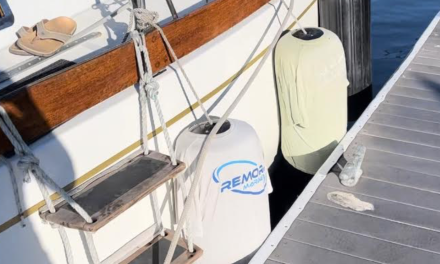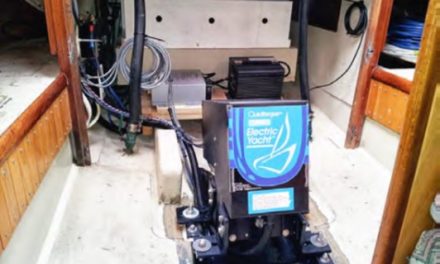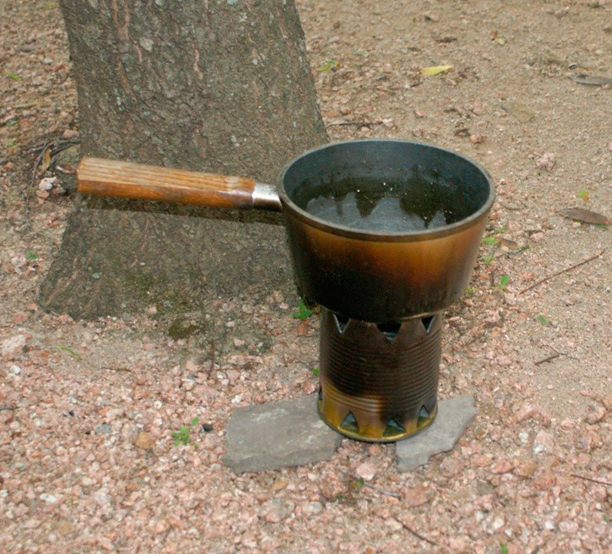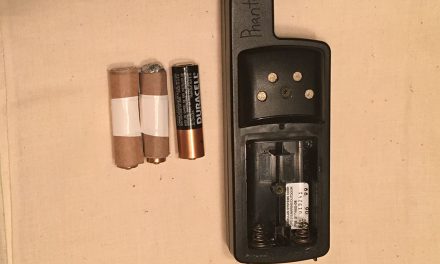
Sailor and writer Webb Chiles is credited with saying something to the effect that when the engine in his boat died he was set free – no maintenance chores, no need to get fuel, no more worries associated with whether it would run or not.
I am married to a refrigeration engineer who was prepared to design the onboard refrigerator to beat all refrigerators, but the choice to live without an icebox during a recent vacation set us free in ways we hadn’t expected. There was no need to run to civilization in a quest for ice. We had no worries about the quality of the food left on little ice or concerns about what must be eaten soon because it surely must have been thawed too long. And we didn’t have to run the engine to keep a refrigerator alive.
Above all, our icebox was no longer a bottomless cubicle, the purpose of which seemed to be storing ice and little else. It became, instead, a marvelous vast storehouse for flour, spices, and canned goods. It offered stowage space the likes of which I’d never had on our bilgeless racer/cruiser.
The biggest freedom was in the escape from civilization. We generally take our vacation cruises to the north shore of Lake Superior and Isle Royale National Park. In that part of the world, marinas and facilities are not handy. Civilization is usually at least a day’s sail away. With ice melting in about six days, our stays in the wilderness were limited to about four days at a time or longer if we went without once the ice was gone, but planning for the transition is a bit challenging.
To avoid the awkward stage, we had proposed two possibilities: build a refrigerator or learn to live without ice. We chose to try the sans ice approach first. We may never again consider the alternative. Our diesel engine thanks us for making this choice, since it won’t have the wear and tear associated with running a couple of hours a day for the sake of cold food. And we’ll avoid the need to return to civilization in search of fuel to power the engine that keeps things cold so we don’t need to return to civilization to buy ice. (If that isn’t a Catch-22, what is?)
My first major adjustment, as provisioning officer onboard Mystic, was in cooking to avoid leftovers. At home I thrive on making large batches – pots of spaghetti for example – so I can freeze the excess for later use. Frozen blocks of spaghetti sauce and other mass-produced meals also helped when we were living with a cooler. They served as “ice units” until thawed. Then we ate them. On board, with an ice chest for food storage, I couldn’t cook by the potful, but saving leftovers to eat another day was not much of a problem.
With our changed lifestyle, however, I began buying the smallest cans and jars and thinking critically about how much rice or pasta to cook. It’s a science. You don’t want to go hungry, but on the flip side, you don’t want to encourage overeating. And you certainly don’t want to throw food away. We found, fortunately, that leftovers easily last one day, so when I miscalculated, we polished off the rest the following lunch or dinner. Some leftovers worked out nicely as omelet filling for the next day’s breakfast.
Eggs don’t need ice
Omelets require eggs, of course, and we typically think of eggs as something requiring refrigeration. In her book, Cooking on the Go, (from 1971 and unfortunately out of print) Janet Groene argues that many foods do not need refrigeration:
“Because we have roomy refrigerators at home, we get in the habit of chilling many items that can be kept safely without refrigeration. Cheeses and sausages traveled the world long before the days of refrigerators or ice lockers.
“Of course you keep fresh meats chilled for safety, but we have kept cooked meats for second and even third appearances on our table. Packaged bacon doesn’t last more than three days in warm temperatures, but well-salted pork and slab bacon, as well as cured hams, date back hundreds of years before the discovery of electricity — it really isn’t necessary to go without many of the items you keep refrigerated at home.”
Groene notes that not too long ago people packed fresh farm eggs in salt, where they kept for a year. In three and a half weeks, we never had an egg go bad onboard Mystic, although I was skeptical at first. There are a number of actions you can take to help eggs last. One set of routines deals with sealing the shells. These involve smearing them with shortening, Vaseline, or salad oil. Other people swear by dipping them exactly two seconds in boiling water. Another set of routines involves keeping the inner membrane moist by turning the eggs regularly. Mother hens do this on the nest. Just to be safe, I decided to grease the shells with Vaseline AND turn them every day. It’s possible that either method would have been enough.
We are not big egg eaters at home, typically, but we left for vacation with nearly four dozen eggs, since I planned to use them in baking, hard boiled in salads, and in omelet making.
In the beginning I was cautious and tested each egg before using it. People who have lived without refrigerators suggest that you crack each egg into a separate container and not directly into your frying pan or bowl full of ingredients, so if it is bad, you can toss just the egg and not the rest of your meal. Even before breaking an egg, you can test it in a glass of water. If the egg has developed gas and floats, it’s bad. If it sinks to the bottom of the glass, it’s good. It’s a bit like testing for witches in Salem. If she floats, she’s a witch and has to be burned at the stake. If she sinks, what a pity. We’ll let the record show that she wasn’t a witch. This time-honored test works better for eggs than people.
Cheese tricks
Refrigerators and coolers are also nice for keeping cheese. How do you go three weeks without cheese, we wondered. As it turns out, grated parmesan can last, as can cheese that comes in wax. In her book, The Care and Feeding of Sailing Crew, Lin Pardey talks of long-life processed cheese that can last up to two years without refrigeration in sealed containers, and of other wonders, such as canned cheese.
Lin probably led the way for all of us who have tried the non-refrigerated lifestyle. Not that she did so on purpose. She appears to enjoy cooking, and she and Larry both prefer fresh foods. So Lin prizes her well-insulated cooler on Talesin. Unfortunately the Pardeys’ icebox runs out of ice on long passages and at anchor, just as ours does. As a result, Lin wrote The Care and Feeding in 1980 and republished it with new information in 1995. It’s a terrific reference for anyone provisioning for a long trip or planning to do without ice.
Lin reports that waxed cheeses keep perfectly for up to two months at temperatures below 55 degrees F. Unwaxed cheese, she says, “should be wiped lightly with vinegar and then wrapped in plastic wrap and stored where it will not be bumped around too much.” She also discusses storage of feta and hard cheeses in oil.
I read Lin’s book after we returned from our trip, however I had heard that cheese stored in olive oil will keep, so I tried that. I kept chunks of cheddar and havarti for three weeks in containers full of oil. The Tupperware container leaked and was a mess to store, but a jar with a tight lid worked very well. This process offers a nice way to store oil for cooking, too. The cheddar lasted well, while the softer havarti turned very mushy before we returned to civilization. Hard cheese is the key for this storage technique. Lin mentions in her book that cheese becomes “creamier” as it ages with this technique. I’d second that opinion. Lin’s directions for storing cheese are more elaborate than mine and sound like a process worth trying. She also mentions the concept of waxing your own cheeses and of the “drunken Stilton.” All of this is in the chapter she titles “Day 37” and should be in either version of her book. The Pardeys’ books were available from the Good Old Boat Bookshelf.

Baking aboard
The next obvious problem with life without an icebox is what to do when the bread turns blue. Over the past year or two we’d experimented with onboard bread baking. We’d cooked bread in our pressure cooker, pan-fried Indian fry bread, and baked a couple of yeast loaves. We make muffins regularly, but creating good bread was a bigger challenge. I wasn’t crazy about the taste of the pressure-cooked bread, and baking yeast loaves seemed messy and time-consuming. This year, however, I came armed with 40 pounds of white and wheat flour (twice as much as we needed, it turns out) and a number of new yeast recipes. The second recipe we tried turned out to be such a winner that we never tried another one. It simplified the risings and didn’t seem so messy somehow. It was a mock French bread from the James Beard Cookbook, and we liked it so much we’ll be cooking our own bread with all that extra flour this winter even though Minneapolis abounds with wonderful bread shops. (Recipe is below.)
With each baking I made two small loaves. The first we consumed almost in its entirety straight from the oven. There may not be anything better than warm bread, and we reveled in the luxury of having it. The other loaf lasted a couple of days. Now that we’ve discovered this easy bread, we may leave the dock with fewer loaves of the store variety. We prefer those we can cook ourselves, and the vacation lifestyle seems to encourage the breadbaking routine. Marilyn Palley (wife of Reese Palley) recommends a book called, Fast Breads! by Howard Early and Glenda Morris.
Bread recipe
(from The James Beard Cookbook, 1959*)
- 1 package yeast
- 2 cups lukewarm water
- 2 Tbs. sugar
- 1 Tbs. salt
- 5-7 cups flour
- (one egg white, if desired)
- Dissolve the yeast in the lukewarm water in a large bowl. Add sugar and salt and dissolve them. Gradually add flour.
- Turn out on a table and knead. Cover with the bowl and let it rest for 10 minutes. Knead.
- Let it rise in the bowl for another 1-2 hours until it’s double in bulk. Knead.
- Form into two loaves (French-style long ones, round ones in an oven-proof bowl, regular pan loaves, etc.). Sprinkle the bottom of each container with cornmeal and place the bread on it. You don’t need to grease these pans. Slash the tops of the bread and spread with an egg white, if desired. Let the bread rise another five minutes.
- Place in a cold oven and turn it on to 400. It should cook in 35 minutes. (In reality, with our boat oven, we turn the temperature on about halfway, whatever that setting might be. Then when we think about it, we turn the temperature up all the way. We remove the bread when it looks done, but it probably takes longer than 35 minutes.)
*My copy was purchased in the 1970s, but I guess it is a bit of a relic.
Meat or meatless meals
Meat is another issue for the sans-cooler cook. While we don’t eat as much meat as we used to, we weren’t ready to go without. Canned chicken and ham are available on the grocery store shelves in small tuna-sized containers. I also found small containers of corned beef and tiny little hams, canned shrimp and crab meat, salmon, and fish balls.
There are a number of spreads along the lines of deviled ham and chicken. And of course there are small canned hot dogs (masquerading as sausages), Spam and other “delicacies.” I also planned to supplement our supplies of meat with completely acceptable no-meat pasta meals. Jerry wasn’t so sure he’d find even the occasional vegetarian meal to be all that acceptable. There’s nothing quite like being held captive a day or two from a grocery store and learning there’s nothing on board you like to eat. He may have feared this new “adventure” to be a ruse of mine to take a few pounds off him when he would be unable to defend himself. (See article below for his thoughts.)
I had just finished reading Don Casey’s book, Dragged Aboard, in which he makes it seem like anyone is capable of canning meat. I was inspired by this and shared the book with Jerry, who went on a dedicated hunt for a larger pressure cooker – one capable of doing canning. The small one on our boat was not up to the task. In the days of microwaves, instant meals, and grazing, pressure cookers are becoming a thing of the past. Small ones, such as our boat pressure cooker, were available, but large ones may be disappearing from the North American scene along with buggy whips.
Jerry’s search began with Target and K-Mart, where the small ones can be found, and moved to an upscale home cooking specialty store, where a sweet young clerk asked in all innocence, “Pressure cooker? Is it an electric appliance?” and led him to the toasters and coffee makers. Once he found the pressure cooker section, there were only small ones and another clerk who asked, “What do you do with one of these anyway?”
The obvious answer, for anyone who grew up with a mother who used one frequently, is you blow up your kitchen with these devices. It seems we all have fear-of-pressure-cookers tales to tell. Perhaps that’s why they’re falling from favor these days. Jerry finally landed a full-sized canning pressure cooker at the Fleet Farm store, a chain in our part of the country that caters to farmers, truckers, and other independent types.
By now, however, we were only a couple of weeks away from the start of our vacation, and wewere in the usual pre-trip blitzkrieg of vacation preparations and work project wrap-ups. I was no longer interested in canning additional meat for our trip. One evening we invited Jerry’s younger daughter over for dinner, and I prepared a pork roast and simultaneously baked a couple of turkey thighs for use in the next night’s meal. Jessie is a marvelous pitch-in gung-ho daughter, and before the evening was over, the three of us had canned the remaining pork roast and turkey as a great group activity. We left for the trip with 11 half-pint jars of the best canned meat we’d ever tasted. Next year we’ll do more of this and include cubed beef and hamburger.
Mayo’s not untouchable
We hear so many stories about mayonnaise and are likely to be confused by them. I’m no expert on the subject, but my current level of understanding is that if the stuff is kept pure, it can last. Mayonnaise mixed with other foods must be kept cool, it would seem. And you shouldn’t “contaminate” a jar of mayonnaise by sticking a utensil back in there after it has been in contact with other food.
We have heard of some people getting small packages of mayonnaise from fast food places for their boats. That works, too. We bought small squeeze bottles of mayo, and one lasted two weeks. It was emptied before it began to smell or cause any concerns. Unopened jars of mayonnaise sit on grocery store shelves for months. As it turns out, they can do the same once they’re opened, as long as other food doesn’t come into contact with the mayonnaise. I’d love to understand why this is so and will welcome further dialogue on this subject for our Mail Buoy column.
Milk is a problem
Cold milk only lasts a week or so. If it isn’t kept cold, the number of days diminish dramatically, of course. I like milk. As an aging woman, I need to drink it or get my calcium in some other form. So I missed this on our vacation. I bought powdered milk, which we used in cooking, but I used it on cereal twice and never again. I never drank it straight. Jerry can happily drink that stuff, and I really wanted to be able to do so also. But life’s too short. I ate cheese and took my vitamins. I’m told that UHT (ultra heat-treated) milk is a passable substitute, but I don’t have any experience with it (and it doesn’t appear to be available in the U.S.).
The following information is from Michael Greenwald’s The Cruising Chef Cookbook, an excellent cooking resource I’ve just discovered (Paradise Cay Publications, 1996.):
“Pasteurized milk takes up precious space in the refrigerator and spoils within a few weeks. Long life, ultra heat-treated milk is an unrefrigerated product which comes in a paper box. It tastes as fresh as pasteurized milk, contains more vitamins, and lasts six months without refrigeration. It comes in half-quart and quart (liter) boxes which are slightly more expensive than refrigerated milk. This product is hard to find in the USA but is the most common way of buying milk in many parts of the world.”
Margarine lasts well
Butter and margarine are also part of the non-cooler cooking equation. I had read somewhere that stick margarine, softened and repackaged in plastic tub containers, keeps well without cooling. This is true. I had feared that it would turn into liquid gold without the help of an icebox, but it did not melt. Toward the end of our vacation, when we did a touch-and-go in civilization for diesel fuel and a pumpout, I was able to buy a few groceries at a camping store. We were running short on margarine, so I bought a couple of sticks of butter. I repackaged these sticks in the margarine tubs, and the butter lasted as well as the margarine did.
Fruits, vegetables suffer
By the end of three weeks, we were left with apples, oranges, grapefruit, potatoes, onions, garlic, and cabbage. We also had a large assortment of canned fruits and vegetables. The other fresh fruits and vegetables had long since vanished, and even the apples and oranges had seen better days. I had read about a West Marine product called Evert-Fresh bags, which keep certain fruits and vegetables fresh longer. These bags were particularly recommended for lettuce. The lettuce must be absolutely dry when placed in the bag, however. Unfortunately I shop at one of those stores which tries to impress shoppers with a fine-mist spray on the leaf lettuce and spinach. Even when I’m not provisioning for a trip, I hate that “blamed” mist.
I waited until the last day possible to purchase the fresh foods for our trip and wound up at home trying to dry out the leaf lettuce and fresh spinach. Something halfway, but not completely, dry went into the Evert-Fresh bags. The result was that these foods didn’t last as long as they might have in a fresh-air environment. Wiser now, I will try this again with improved drying on our next vacation.
Ice for drinks? Come on!
Cold drinks aren’t terribly important to us. We didn’t miss ice for our drinks, since we don’t tend to put ice in them anyway. However, Lake Superior stays cold all summer long. The 50-degree water is an excellent cooler for cans and bottles, if we choose to use it that way. We found that storing cans next to the hull below the waterline was enough for us.
We did meet one cruising couple traveling with a freezer, who offered to give us some ice, since they felt so sorry for us. But I had to turn down the offer. What could we do with a small supply of ice, when our cooler was already filled with bags of flour? Another pair of friends who anticipated seeing us on that vacation had just gotten their cantankerous refrigerator to work after several years of frustration. They were so self-assured now with their working freezer that they threatened to sail by pummeling us with frozen Brussels sprouts. This wasn’t pity. This was revenge Š perhaps because we had chosen the easy way out.
No big deal, really
Living without the cooler was not the challenge I had thought it would be, but I wasn’t alone in believing that we were facing a tremendous lifestyle change and challenge. When buying supplies at the grocery store one day, my collection of purchases looked a bit unusual, so I mentioned to the clerk there that my husband and I were going off into the wilderness for three and a half weeks without refrigeration or a cooler. The clerk was so impressed you’d have thought we were heading off to scale Mt. Everest without gear.
But in fact Jerry and I were just going back in time to great-grandmother’s day Š to a time even before the ice man came around from door to door Š back to a time when people canned and prepared food for the seasons when they wouldn’t have any. Most of these people never had the luxury of sailing off to remote places in sailing yachts and living from the stores they had aboard. (Even the menus of the sailors of the same time period were far from grand.) Their lives seemed hard and uncompromising, while we experienced the best vacation we have ever had. There were no hardships. We were better off without the trappings of civilization because we didn’t experience the tyranny of ice or endure the rattlings of the engine in order to keep a refrigerator going. Great-grandmother never had it so good.
No cooler? What did you EAT?
Perhaps I can share a few menus – not recipes – I’m all for simple, uncomplicated onboard meals. I don’t go along on sailing trips as the galley slave. I want to be on deck sailing and sightseeing, not below creating gourmet delights. My ideas were culled from those who’ve been there and done that: sailors Cathy and Dan Haupert, sailors Ken and Pat O’Driscoll (who introduced us to cold pasta salad even though they were using a refrigerator), sailing writers Reese and Marilyn Palley, author Janet Groene, and world cruising women who communicate on a listserver I subscribed to. Next year I’ll incorporate meal ideas from Lin Pardey also.
Typical breakfasts included omelets, cereal with blueberries or bananas (early in the trip while we still had the fruit and before I decided that powdered milk is not a beverage fit to ruin good cereal and fruit), pancakes, eggs, French toast, oatmeal, and coffee cake.
Typical lunches included ham, tuna, or chicken salad sandwiches; pasta salad; grilled cheese sandwiches and soup; peanut buttersandwiches; and leftovers. Canned spreads worked as picnic food when we wanted to leave the boat and spend the day exploring. Wary of taking a pre-made chicken salad or similar mayonnaise-based lunch along for a day in the sun, we ate strange spreads from small cans. These are adequate, but not exciting. The best is the deviled spread, but variety in all things mundane is best. They all got dull and downright boring after several similar lunches. But they fueled our bodies, and the sights we were able to take in while unattached to the mother ship fueled our souls. It’s a tradeoff.
Dinner presented more variety. We had salad in the beginning, fresh broccoli for a while, and an endless variety of ways to cook potatoes. Canned vegetables picked up where the fresh food left off. Dinners included mashed potatoes with the meat we canned; pasta with beef and broccoli; chicken with rice and spinach; stuffed cabbage using canned corned beef; pasta with sauce (small jars of marinara, alfredo, clam and other sauces are available in the stores); and corned beef and cabbage.
I got creative with cold pasta dinners. Some of our favorites included pennette rigate pasta with canned corn, olives, canned shrimp, chicken, or no meat at all. After one such meal, Jerry vetoed the use of canned crab for this, but others might like it. I did. All this went well with whatever else I had to throw in. Carrot slices, hard-boiled egg slices, and artichoke hearts work, too. We mixed these ingredients with oil and vinegar dressing. I bought several small jars of prepared salad dressings for variety, but preferred the oil and vinegar styles best. Mayonnaise would work, too.
We made a scalloped potatoes and ham recipe in the pressure cooker that has been a real winner for two years now. We tried some prepared rice packages: curry, saffron, stir fry rice, lentils and rice, black beans and rice, red beans and rice, and so on with our canned meat or with canned sausages (a.k.a. hot dogs). Salmon fish cakes mixed from canned salmon and mashed potatoes were a big winner. The possibilities were endless.
Jerry (ever the engineer) suggested several years ago for our standard two-week vacations that I create full menus on a spreadsheet and then sort this by item to determine how much of each item to buy. It’s far more organized than I would have been, but it worked very well. However, when asked to share our provisioning lists with fellow sailors, I realized how hyperdetailed our food preparations appeared to be.
This year’s longer trip helped me understand for the first time what planning must be like for a much longer voyage without reprovisioning stops. Although I did create daily menus, I didn’t live by them. I had so much variety aboard in our food lockers that I cooked serendipitously Š more like I do at home. It starts with, “Let’s see, it’s somehow gotten to be dinnertime. What needs to be eaten? What is fast to prepare?” And finally, “What would we like to have tonight?” I often referred to my onboard menu lists for inspiration, but I was able to manage the use of fruits and vegetables, eggs and potatoes, leftovers and partially used cans of things more effectively without the constraint of a previously prepared menu.
This is how we’ll go in the future. Menus will guide my shopping and help inspire my cooking, but daily meals will be planned at the time of the meal. That might be called “just-in-time menus.” I’ll keep the food lockers supplied as I would at home, and meals will happen when they happen. From now on, we will not bother with the hassle of ice for our weekend trips. We won’t take a cooler full of ice and a few perishables back and forth to the boat. Even for weekend trips, we have been set free.
You what? Tossed out the cooler?
The first time Karen suggested that we spend a whole vacation without ice, I talked her out of it. I had visions of a very unpleasant couple of weeks eating some of my least favorite foods — all from cans.
I’d been a refrigeration engineer for about 29 years, and I had some strong ideas about what kind of refrigeration system should be installed in our C&C 30. I’d been designing the system in my head and on paper for about five years. I wanted something with less than half the run time of currently available systems, because I knew that once there was a refrigeration system on board, it would dramatically increase the energy budget. I’d heard horror stories of boats that have to run their engines one, and in some cases, two hours a day to keep that little tiny box cold. I didn’t want the noise, wear, and fuel consumption. The design that I came up with was complicated and unproven, and it would add 70 to 100 pounds to the weight of the boat. Even doing all the work myself, the parts would not be cheap. Although I targeted much higher efficiency, the boat’s upgraded electrical system would be taxed to about the reasonable limits of its capacity. I had put off building this monster for five years. Ice is really simple, and 70 pounds of it holds our icebox for six to seven days. We’d have to live on the boat forever to pay off the refrigeration system with the savings in ice.
The problem was that we really wanted more range on our vacations. We wanted to go out and stay out for more like a month without having to resupply anything. We’d solved most of the problems in doing that by the time Karen suggested going iceless the second time. She was more insistent this time. She wanted to do the research for an article, she said. That did it; I caved in. Well, almost caved in. I rushed out and bought a pressure canner and quickly canned some pork and turkey before we left. These meats proved tasty, and I will can more for next season, but frankly we didn’t need them.
We ate very well for more than three weeks without any ice or refrigeration. The food was good. I enjoyed all the meals except one, which is probably better on average than I do ashore. From a systems standpoint, Karen solved the problem with the lowest-cost, lightest-weight option. The design five years abrewing in my head didn’t compare with zero weight, zero cost, and good meals anyway. Karen truly had set us free.
I was so impressed with what she had accomplished that I suggested that we get rid of the refrigerator at home. It is a noisy, poorly designed thing that just might last forever out of sheer nastiness. She thought that might be going too far.
Moderation in all things, I guess.
Article from Good Old Boat magazine, January/February 1999. This and other cooking aboard articles are also available in the Good Old Boat Galley Book.





